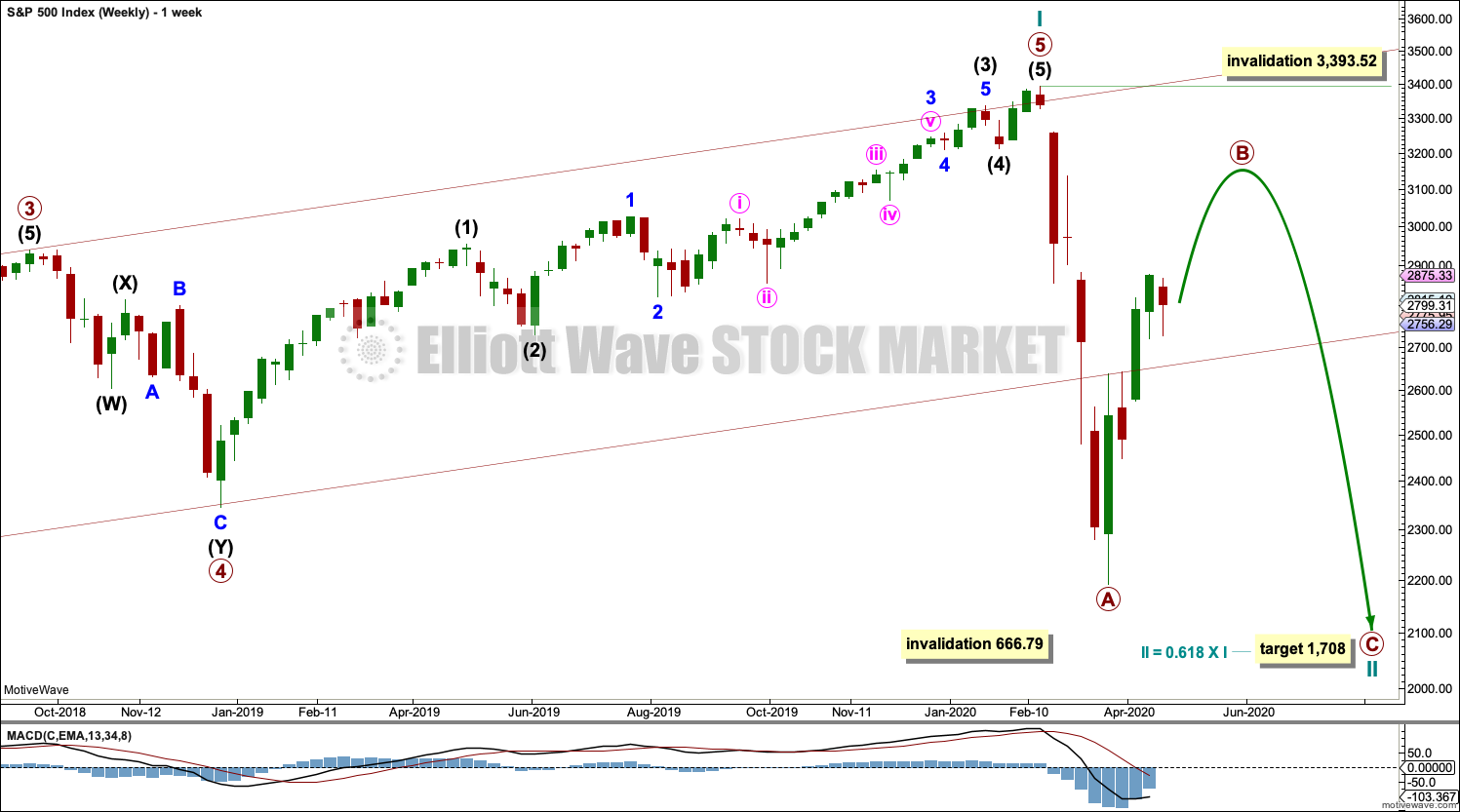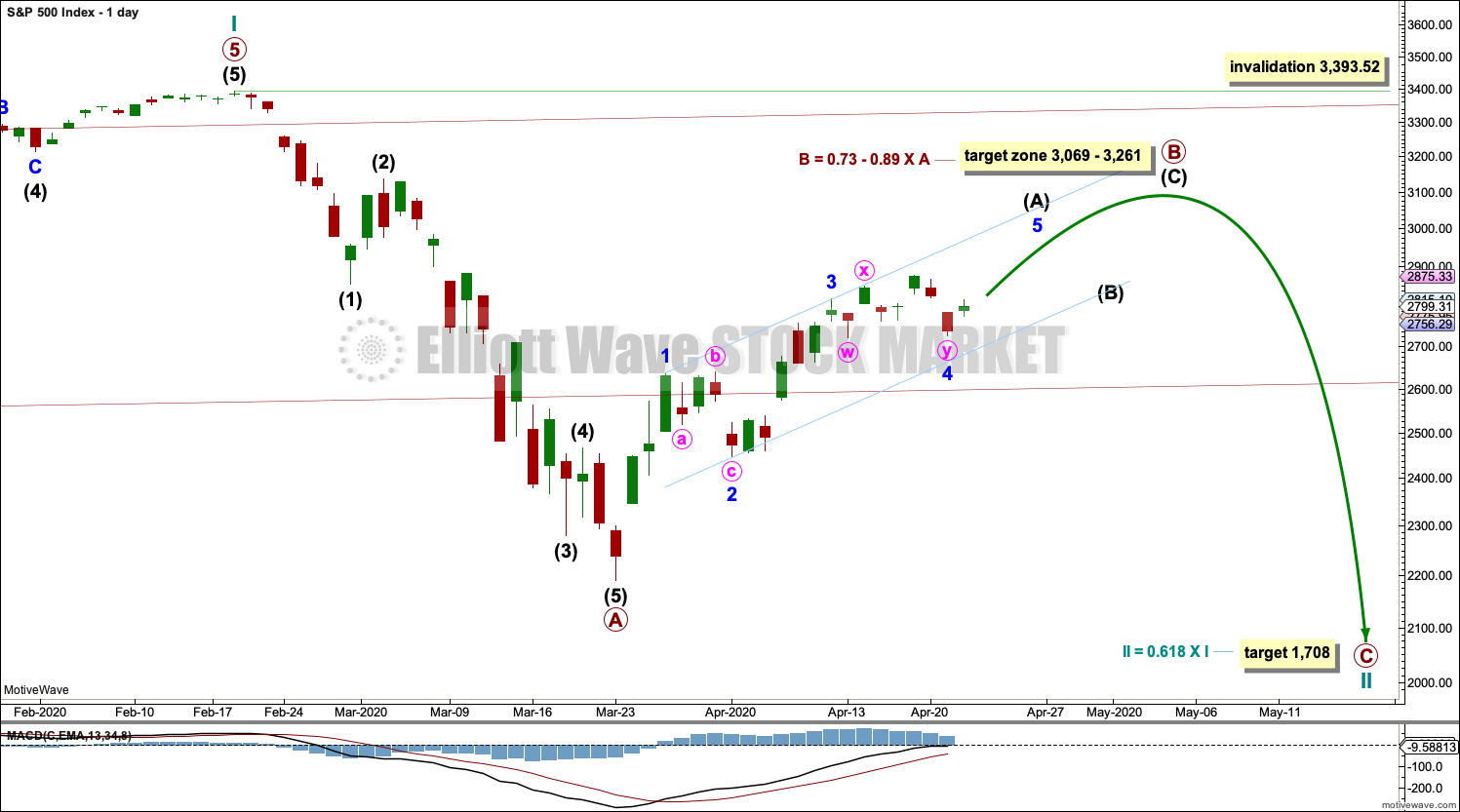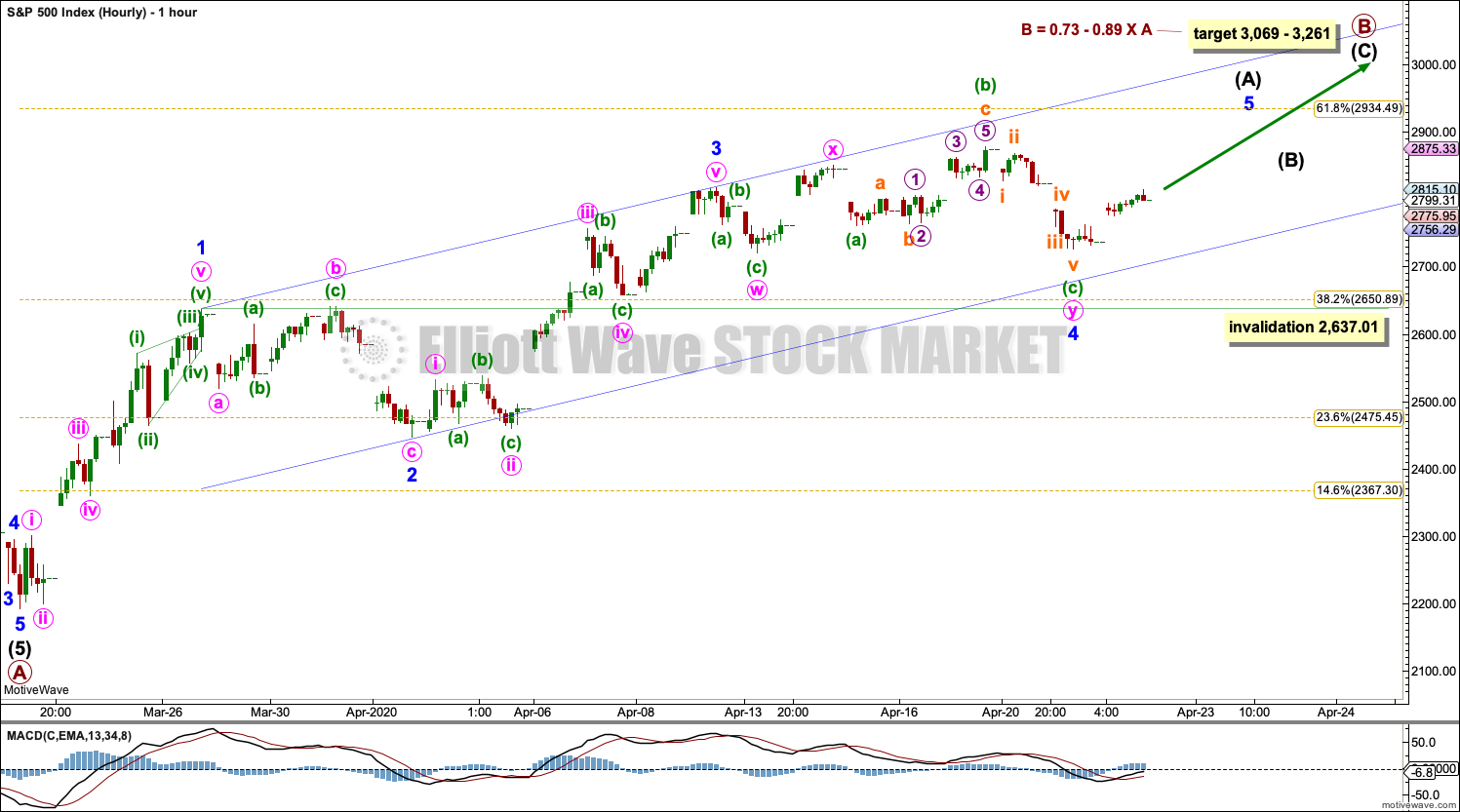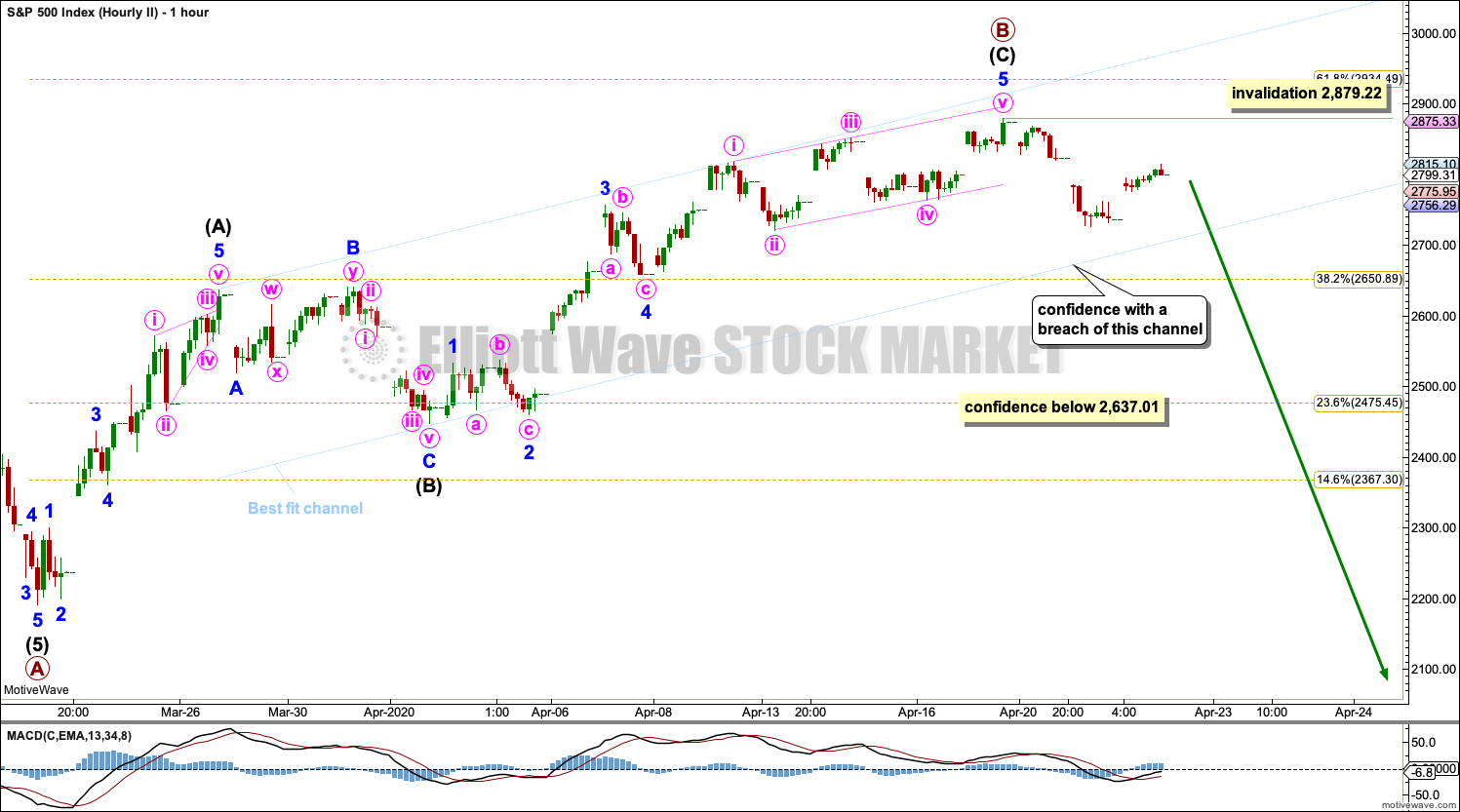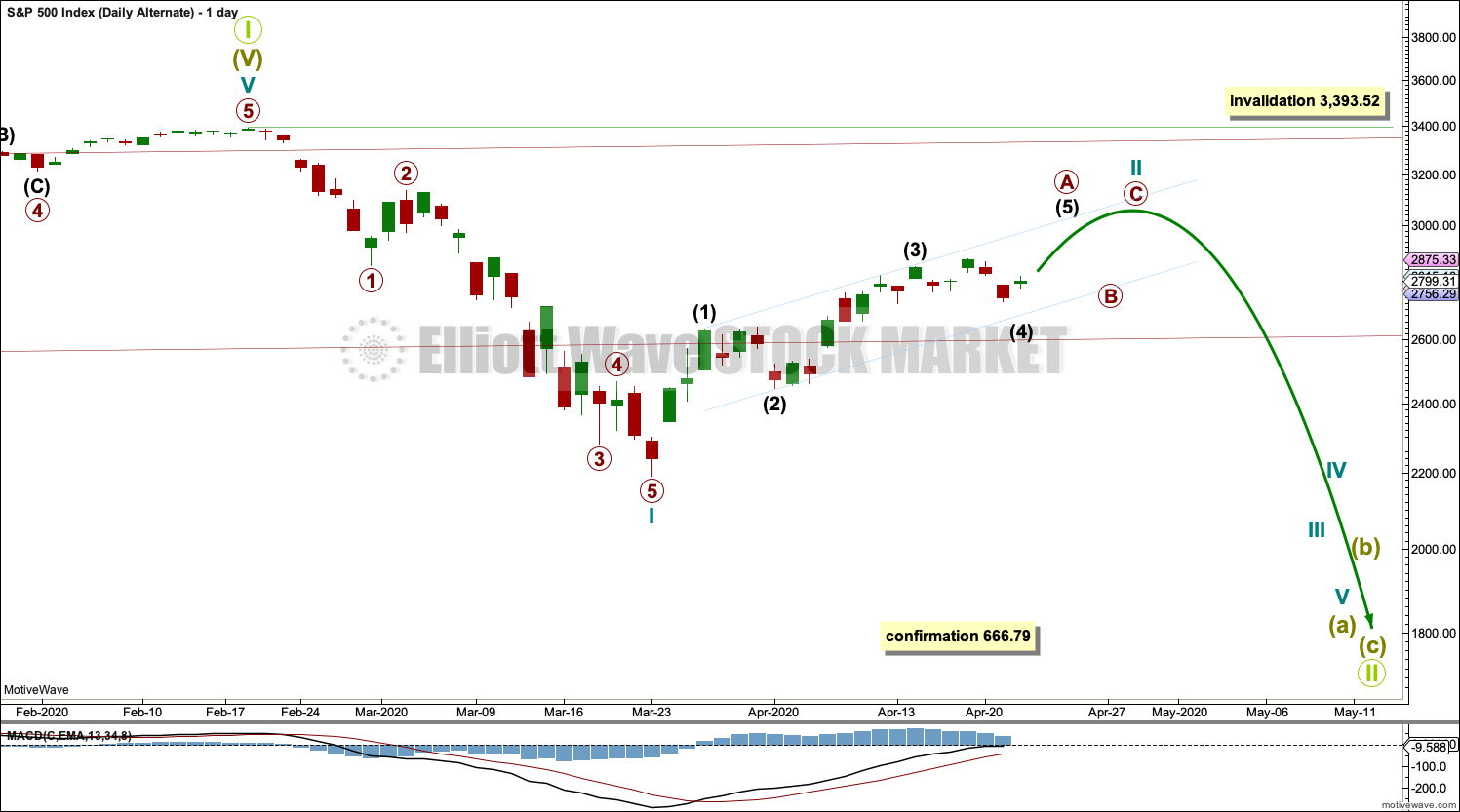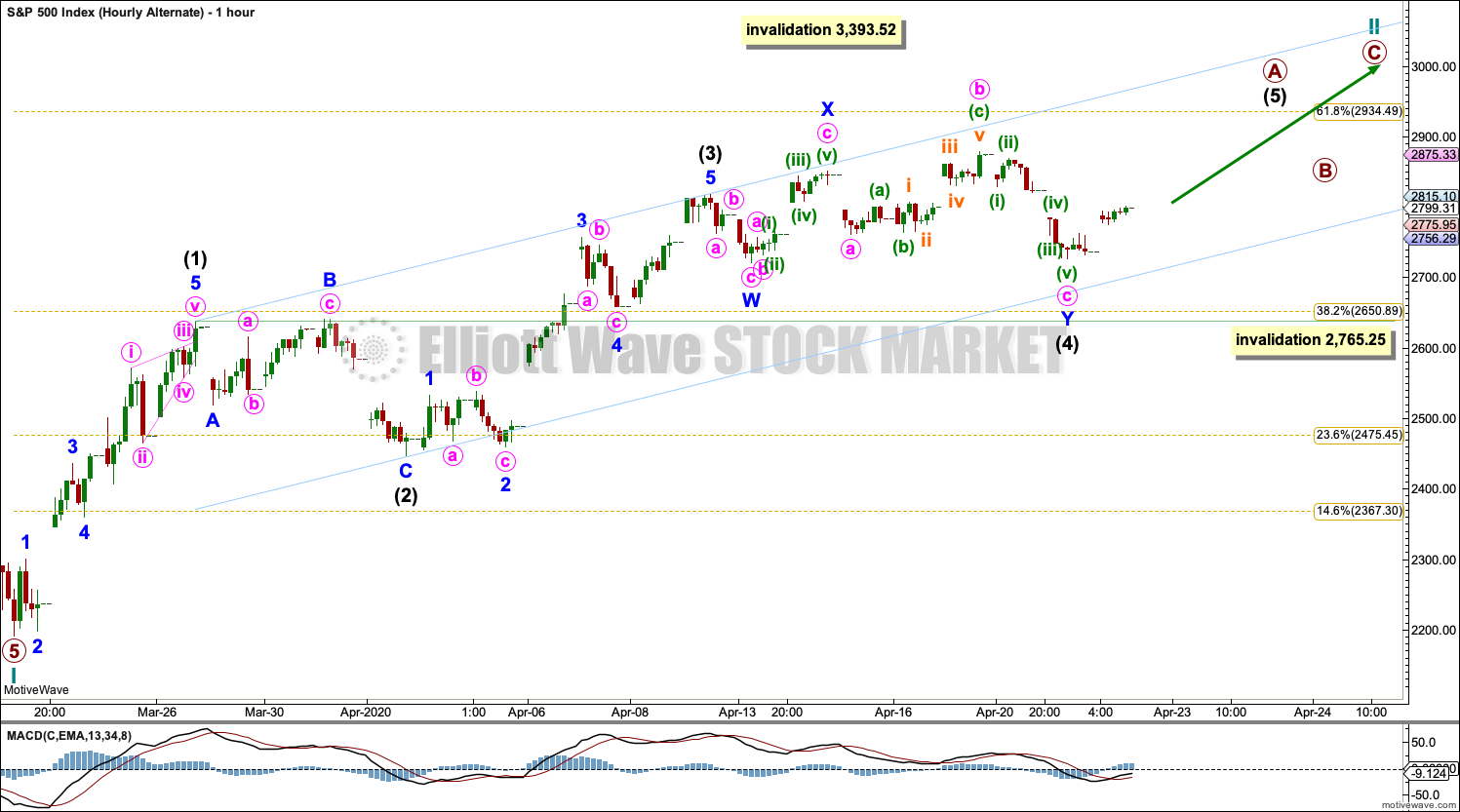S&P 500: Elliott Wave and Technical Analysis | Charts – April 22, 2020
A new channel is drawn and price remains within it. The same target zone is used.
Summary: The bounce may now end about 3,069 to 3,261.
Thereafter, the downwards trend may resume with strength.
Alternatively, a new low now below 2,637.01 and below the new trend channel on daily and hourly charts would indicate the bounce is over and the downwards trend has resumed.
The biggest picture, Grand Super Cycle analysis, is here.
Last monthly charts are here. Video is here. Members are encouraged to view all three monthly charts. The third is much more bearish than this main wave count and remains a valid possibility.
ELLIOTT WAVE COUNTS
WEEKLY CHART
The channel is now breached by a full weekly candlestick below and not touching the lower edge. Further confidence in this wave count may be had.
Price has reached below the 0.382 Fibonacci ratio of cycle wave I at 2,352 on the last downwards movement. The structure of cycle wave II may need further to go to complete. The next Fibonacci ratio at 0.618 is now a preferred target for cycle wave II to end.
Cycle wave II would most likely subdivide as a zigzag; thus far that looks like what is unfolding. When primary waves A and B may both be complete, then the target may be calculated using a Fibonacci ratio between primary waves A and C. At that stage, the final target may change or widen to a zone.
Cycle wave II may not move beyond the start of cycle wave I below 666.79.
DAILY CHART
Draw the wide maroon trend channel carefully: draw the first trend line from the end of primary wave 1 at 2,093.55 (December 26, 2014), to the end of primary wave 3 at 2,940.91 (September 21, 2018), then place a parallel copy on the end of primary wave 2 at 1,810.10 (February 11, 2016). The channel is fully breached indicating a trend change from the multi-year bull trend to a new bear trend. Resistance at the lower edge has been overcome; price has closed above this trend line. A new target is calculated for primary wave B based upon a Fibonacci ratio between intermediate waves (A) and (C) within it. This target would see primary wave B end within a common range for the first major bounce within a bear market.
Cycle wave II may subdivide as any Elliott wave corrective structure except a triangle. It would most likely be a zigzag. Primary wave A may be a complete five wave impulse. Primary wave B may not move beyond the start of primary wave A above 3,393.52.
MAIN HOURLY CHART
It remains possible that primary wave B is incomplete.
So far it looks like a five wave structure upwards may be completing, which is labelled intermediate wave (A).
Within intermediate wave (A): minor wave 2 fits as a regular flat correction and minor wave 4 is today relabelled as a double combination, zigzag – x – flat. There is alternation in structure between minor waves 2 and 4. Minor wave 4 may be complete.
If minor wave 4 continues further, then it may not move into minor wave 1 price territory below 2,637.01.
The channel is drawn using Elliott’s first technique for an impulse. The first trend line is drawn from the ends of minor waves 1 to 3, then a parallel copy is placed upon the end of minor wave 2.
The target zone for primary wave B is calculated based upon a normal depth for the first major bounce within a bear market. When intermediate waves (A) and (B) may be complete, then Fibonacci ratios at intermediate wave degree may be used to calculate a target for primary wave B to end. At that stage, the target zone may change.
SECOND HOURLY CHART
Invalidation of the main hourly chart would provide confidence in this second hourly chart.
This second hourly chart looks at the possibility that primary wave B is complete, falling a little short of the 0.618 Fibonacci ratio of primary wave A.
Within intermediate wave (C): minor wave 5 is an ending contracting diagonal. However, although this structure meets all rules for an ending contracting diagonal, it does not have a normal look; the trend lines do slightly converge, but not by much, and there is no normal overshoot of the upper trend line of the diagonal by the final fifth wave.
If primary wave C has begun, then within it no second wave correction may move beyond the start of its first wave above 2,879.22.
Redraw the channel as shown to be more conservative and contain all upwards movement.
ALTERNATE DAILY CHART
This alternate daily chart follows the Second Alternate Monthly chart published here. Video is here.
By simply moving the degree of labelling in the bull market beginning March 2009 up one degree, it is possible that a Grand Super Cycle trend change occurred on February 19, 2020.
A correction at Grand Super Cycle degree may be expected to last at least a decade, possibly longer. Corrections for this market tend to be much quicker than bullish moves, and so a fair amount of flexibility is required in expectations for duration of the different degrees.
Grand Super Cycle II would most likely subdivide as a zigzag, although it may be any corrective structure except a triangle. It should begin with a five down at the weekly chart time frame, which would be incomplete.
The first wave down on the daily chart is labelled cycle wave I. If this degree of labelling is wrong, it may be too high; it may need to be moved down one degree.
Following cycle wave I, cycle wave II may be continuing higher as a zigzag. Cycle wave II may not move beyond the start of cycle wave I above 3,393.52.
When cycle wave II may again be complete, then a target for cycle wave III may be calculated.
ALTERNATE HOURLY CHART
Cycle wave II may be a continuing higher as a single zigzag.
TECHNICAL ANALYSIS
WEEKLY CHART
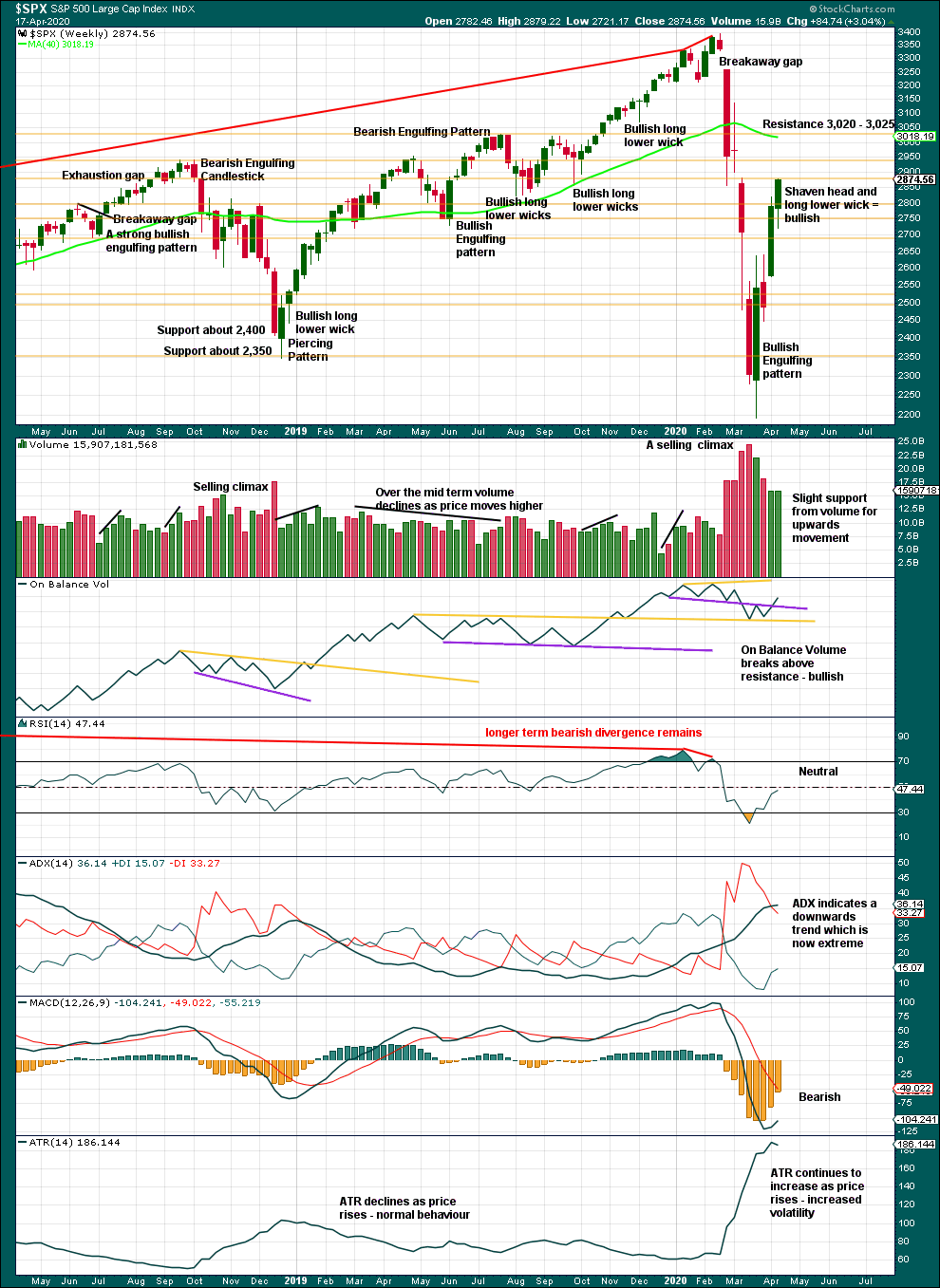
Click chart to enlarge. Chart courtesy of StockCharts.com.
Last week On Balance Volume, a shaven head, and a long lower wick on the candlestick are all bullish. Expect more upwards movement to follow.
DAILY CHART
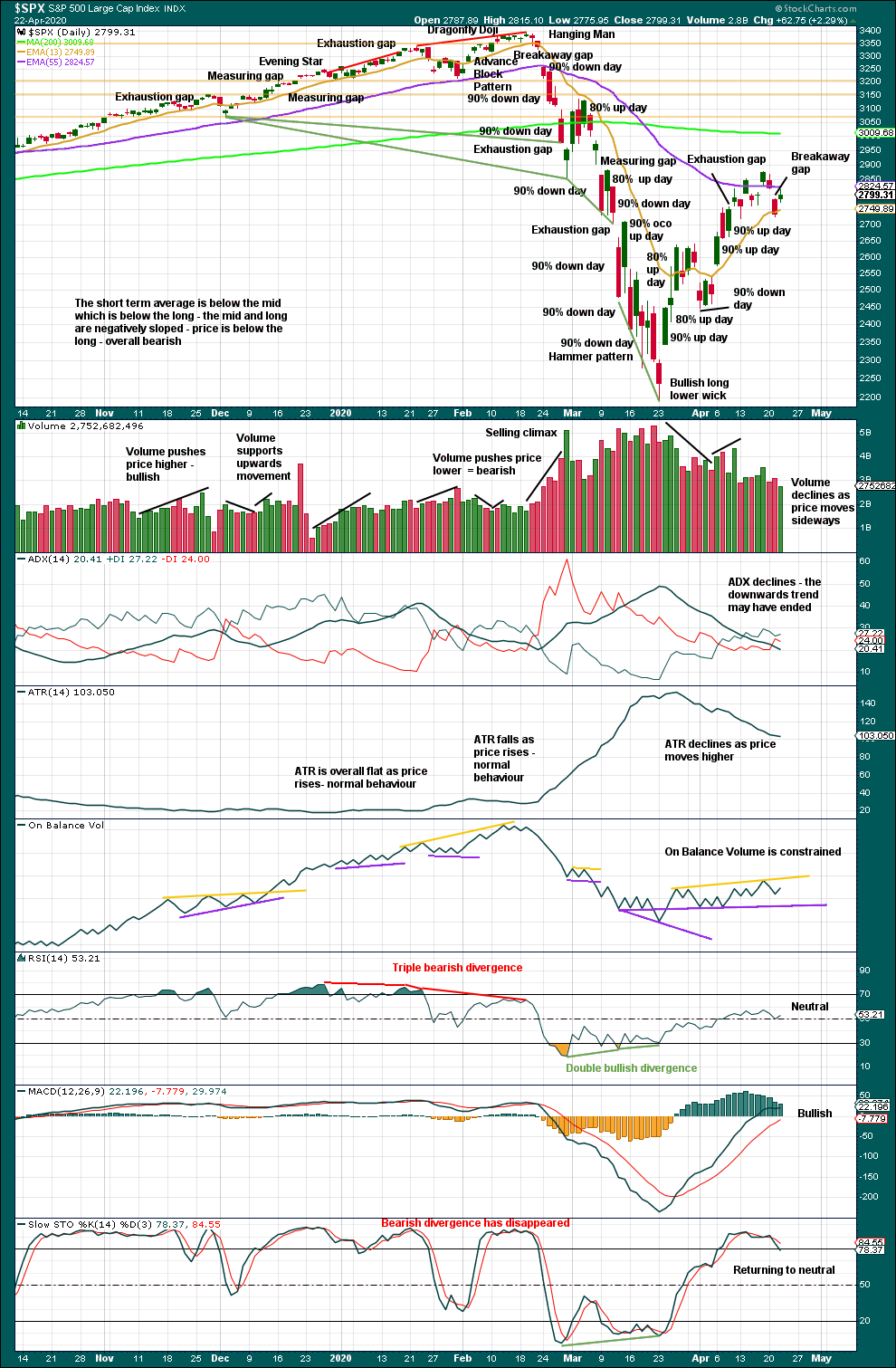
Click chart to enlarge. Chart courtesy of StockCharts.com.
In the bear market from October 2000 to March 2009, the first multi-day bounce retraced 0.73 of the first wave down. In the bear market from March 2000 to October 2002, the first multi-day bounce retraced 0.89 of the first wave down. So far this current bounce has retraced 0.57 of the first wave down, so it seems reasonable that it could continue higher.
To see what signals may be looked for to identify a high, the two previous large bear markets were analysed in end of week analysis. The DotCom crash was analysed here with video here. The Global Financial Crisis was also analysed here with video here.
The breakaway gap remains open. While the gap remains open, it will be possible that a high could be in place. If this gap is closed with a new high above 2,820.43 during the cash session, then the expectation should be for the bounce to continue. There is still no bearish reversal pattern.
BREADTH – AD LINE
WEEKLY CHART
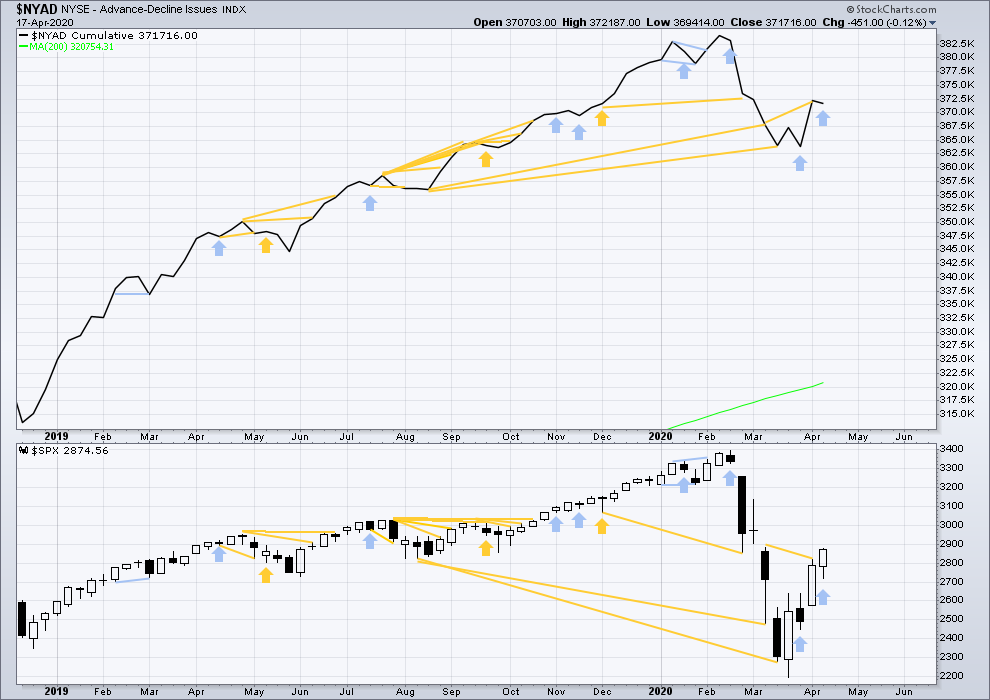
Click chart to enlarge. Chart courtesy of StockCharts.com. So that colour blind members are included, bearish signals will be noted with blue and bullish signals with yellow.
Bear markets from the Great Depression and onwards have been preceded by an average minimum of 4 months divergence between price and the AD line with only two exceptions in 1946 and 1976. With no divergence between the AD line and price at the last all time high, this current bear market now makes a third exception.
In all bear markets in the last 90 years there is some positive correlation (0.6022) between the length of bearish divergence and the depth of the following bear market. No to little divergence is correlated with more shallow bear markets. Longer divergence is correlated with deeper bear markets.
This bear market comes after no bearish divergence. It would more likely be shallow, but this is a statement of probability and not certainty. So far it is slightly more than the 0.382 Fibonacci ratio of the bull market it is correcting (beginning March 2009).
Last week price has moved higher, but the AD line has slightly declined. Upwards movement this week does not have support from a normal rise in market breadth. This divergence is bearish.
Large caps all time high: 3,393.52 on 19th February 2020.
Mid caps all time high: 2,109.43 on 20th February 2020.
Small caps all time high: 1,100.58 on 27th August 2018.
DAILY CHART
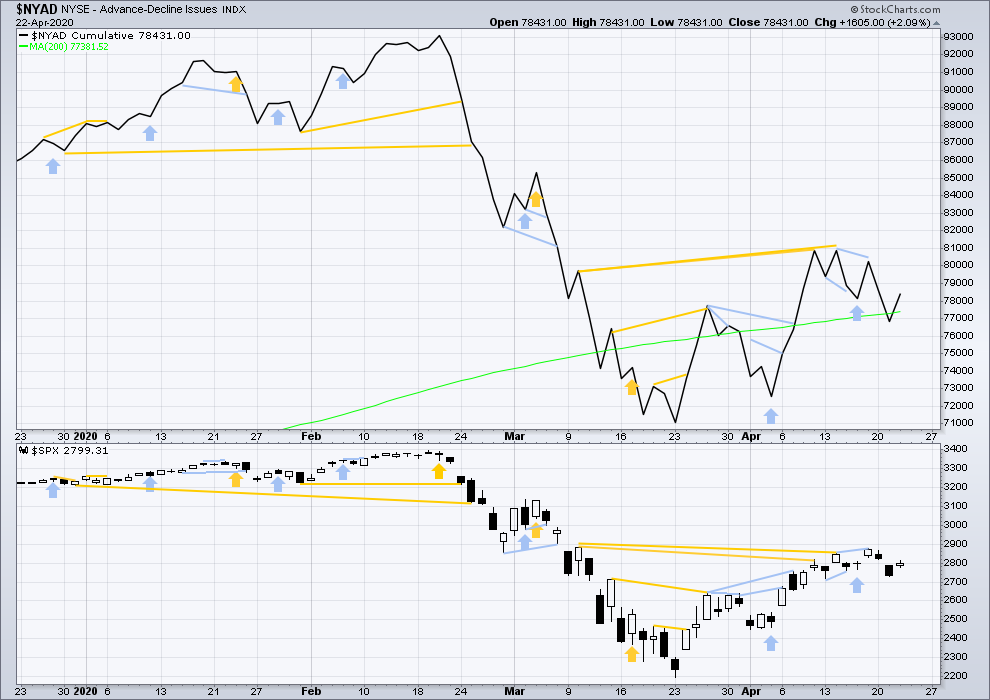
Click chart to enlarge. Chart courtesy of StockCharts.com. So that colour blind members are included, bearish signals will be noted with blue and bullish signals with yellow.
Breadth should be read as a leading indicator.
Today both price and the AD line have moved higher. There is no new divergence.
Only large caps made a new short-term swing high on the 17th of April. Small and mid caps did not. This bounce is led by large caps, which is a feature of an aged market and / or a lack of breadth. This supports the Elliott wave count that sees this bonce as a counter trend movement.
VOLATILITY – INVERTED VIX CHART
WEEKLY CHART
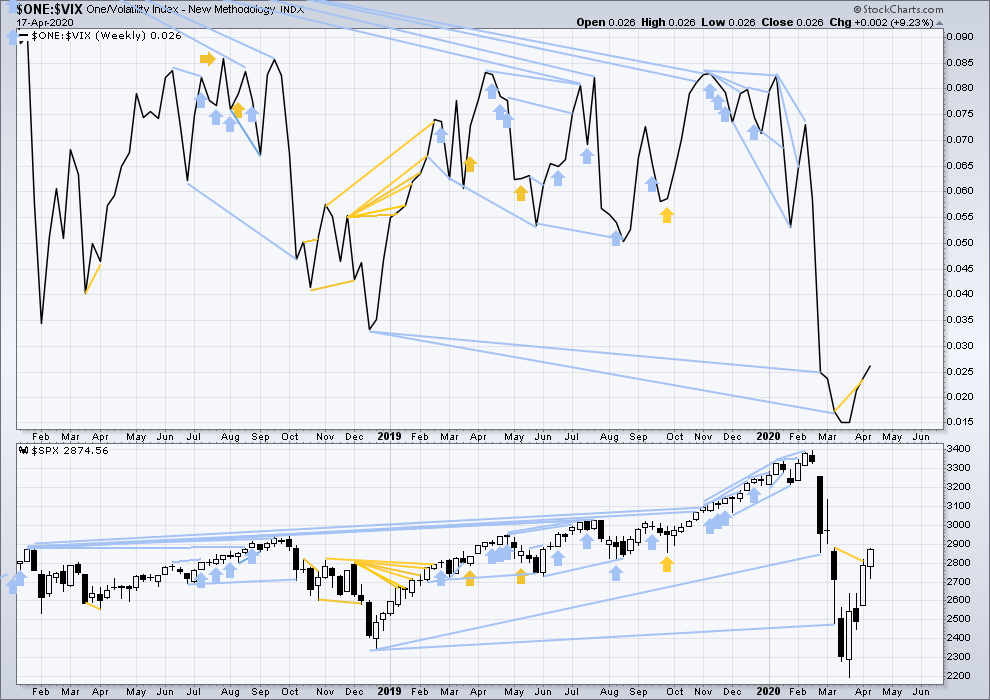
Click chart to enlarge. Chart courtesy of StockCharts.com. So that colour blind members are included, bearish signals will be noted with blue and bullish signals with yellow.
Last week both price and inverted VIX have moved higher. There is no new divergence.
DAILY CHART
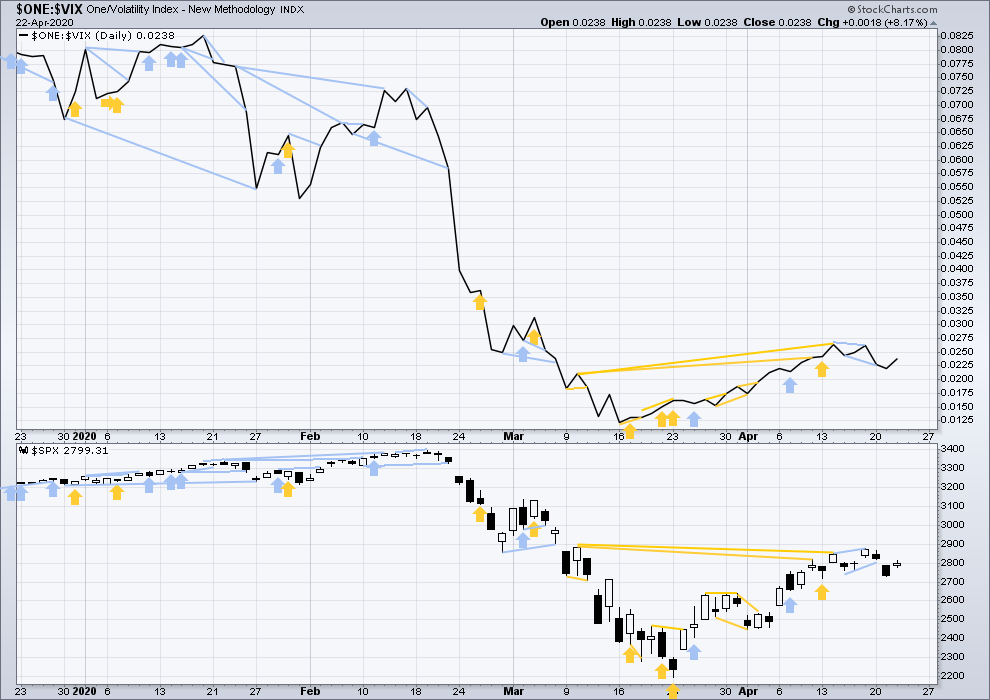
Click chart to enlarge. Chart courtesy of StockCharts.com. So that colour blind members are included, bearish signals will be noted with blue and bullish signals with yellow.
Today both price and inverted VIX have moved higher. There is no new divergence.
DOW THEORY
Dow Theory has confirmed a bear market with the following lows made on a closing basis:
DJIA: 21,712.53 – a close below this point has been made on the March 12, 2020.
DJT: 8,636.79 – a close below this point has been made on March 9, 2020.
Adding in the S&P and Nasdaq for an extended Dow Theory, a bear market has now been confirmed:
S&P500: 2,346.58 – a close below this point has now been made on March 20, 2020.
Nasdaq: 7,292.22 – a close below this point was made on the March 12, 2020.
Published @ 07:09 p.m. EST.
—
Careful risk management protects your trading account(s).
Follow my two Golden Rules:
1. Always trade with stops.
2. Risk only 1-5% of equity on any one trade.
—
New updates to this analysis are in bold.

